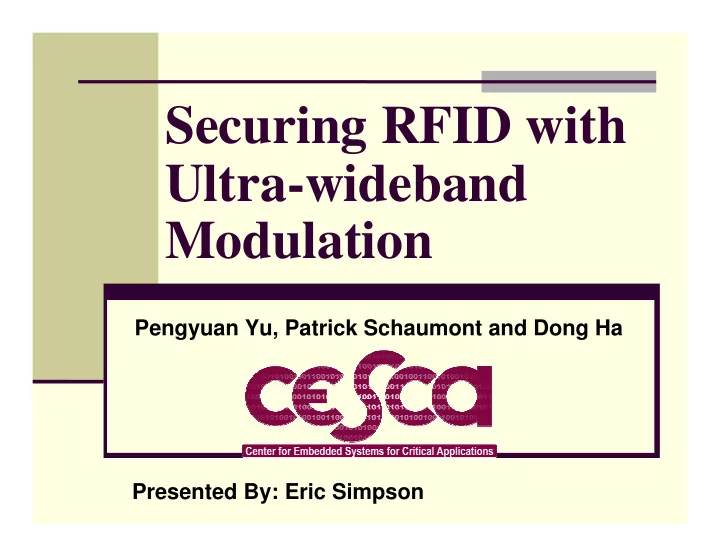

Securing RFID with Ultra-wideband Modulation Pengyuan Yu, Patrick Schaumont and Dong Ha Presented By: Eric Simpson
Summary � Traditional Secure Communications � Securing the physical layer with UWB TH-PPM � RFID digital baseband implementation
Traditional Encrypted Channel Assumption: Eve can intercept and store transmitted data
Insecure Physical Layer with Narrowband Signals � Requires c c omputationally omputationally secure cryptography � Still must meet area, power and latency constraints of an RFID tag � Use of light-weight protocols
Our Approach – Secure Physical Layer � Goal: Secure data by making interception of the data infeasible. Slot 1 Slot 2 Slot 3 Slot “N” . . . Which Slot? Slot 65,536
Benefits of UWB TH-PPM � Can use simple ciphers � 16-bit secret modulation code requires high-end communications equipment � Low Latency � UWB is more robust to interference than narrowband � Allow multiple concurrent transmissions in same band
TH-PPM slot = 1 slot = 4 slot = 2 Time (a) (b) (c) ∆ bit-value = 0 bit-value = 1
UWB RFID Tag Frame Format 10 ms = RFID window preamble (32 bit) ID (128 bit) ID-level 62.5 µ s = bit window bit-level pulse-window = 1 out of 2 16 954ps = pulse window '0' bit '1' bit pulse-level 100ps
TH-PPM � CSPRNG determines time-hopping code � Need to sample all possible time slots if without modulation code � To eavesdrop: � 100 G samples / second � 168 M samples / 8 ms
RFID Tag Architecture CSPRNG edge 64 16 UWB PPM N XTEA Tag RF xmit Reader data 128 Key narrowband receiver ID 128 control Tag Memory & power
CSPRNG � Block Cipher running Output-Feedback Mode � No need for strong encryption primitive such as AES. � XTEA is chosen for its low area cost and low cycle overhead � ~3000 gates with counter registers � Only need 64 cycles � One round determines four UWB pulse positions
CSPRNG counter 64 16 CSPRNG N out dout dout y z start D k0-k3 CTL <<4 done <<5 dout
Pulse Position Modulator � Communicate location of pulses to UWB front-end � Simple Counter implementation infeasible: whole counter running at 1GHz consumes too much power � Delay-Chained based implementation used: � Most power is consumed at high-frequency clock divider logic.
Pulse Position Modulator s[0..15] Ei Eo 1.048GHz 256 KHz s XTEA clock edge_in edge_out clk_out clk_in
RFID Tag Architecture CSPRNG edge 64 16 PPM UWB N XTEA Tag modulator RF xmit Reader data 128 Key narrowband receiver ID 128 control Tag Memory & power
Implementation Complexity Power* Absolute (uW) Relative Gate Count CSPRNG 14.8 2.10% 3264 Delay Chain 662.0 92.20% 382 Control 41.2 5.70% 990 Overall: 718.0 100.00% 4636 *TSMC 0.18um CMOS Vdd = 1.8v
Risk Analysis � Active Attacks � Interference / Jamming � Passive Attacks � Eavesdropping
System Architecture CSPRNG edge 64 15 PPM UWB N XTEA Tag modulator RF xmit Reader 1 data 128 Key narrowband receiver ID 128 control Tag Memory & power
Conclusion � Focus on physical layer security � Results show that the system is technically feasible � Currently working on: � Key distribution � UWB front-end � Clock generation � Investigating multi-access properties of system
Recommend
More recommend